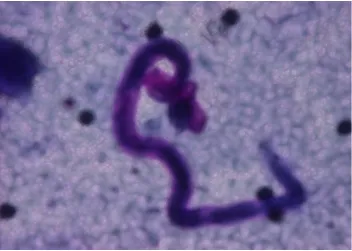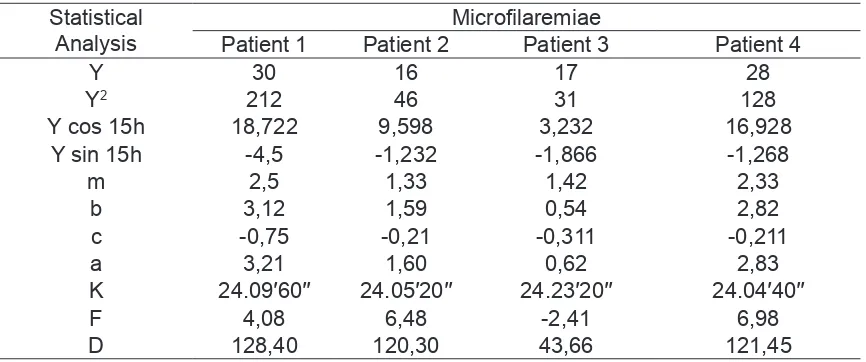O-15
PERIODISITY OF MICROFILARIAE MALAYI AT CENTRAL BORNEO
PROVINCE
Budi Setiawan1*, Tri Baskoro2, Soeyoko2
1Medical Technology Laboratory, Health Polytechnic of Ministry
of Health in Yogyakarta, Indonesia
2 Department of Parasitology, Faculty of Medicine, UniversitasGadjahMada, Yogyakarta
*Corresponding author e-mail: budisetiawantropmed@gmail.com
ABSTRACT
BACKGROUND.Lymphatic filariasis(LF) is one of the major public health problems in Indonesia. All three types of lymphatic parasites namely Wuchereriabancrofti, Brugiamalayi and Brugiatimori
are prevalent in Indonesia. An estimated 125 million people are at risk of filariasis infection, in 337 endemic districts. In Kota BesiSubdistrict there was 51 cases mfpositif, two of them less than 15 years old. Distribution of the disease tends to spread in rural areas and epidemiological dataesspecialy periodicity is needed to eliminated this disease.
AIM. The research aims to find the periodicity of microfilariae in human patients.
METHOD. This research conducted in Kota Besi Sub District, KotawaringinTimur District, Central Borneo Provoince. This is Observational Study with 386 sampel. Examination parasite with Thick blood smear technique and blood is taking at night (08.00 pm– 06.00 am). If a sample positifmicrofilaremia a respondent blood will be taken again to know the periodicity of microfilariae in their blood. Determining of periodicity with Aikat and Das method to calculate a peak of microfilaremia density.
RESULT.Four person of 386 is mf-positive were examined by the fingerprick method.
Brugiamalayi was found in four person mf-positive, microfilariae periodicity in this location
isnocturnal periodicwith harmonic waves and nocturnal sub-periodic with the non harmonic waves.
Conclusion.Lymphatic Filariasis in Kota Besi caused by Brugiamalayiand periodicity is nocturnal and sub periodic nocturnal. Sub-periodic nocturnal is zoonosis so the elimination is different with the anotherspesies of filariae helminth.
Keywords: Brugiamalayi, Lymphatic filariasis, Periodisity.
INTRODUCTION
Filariasisinfects 120 million people in 83 countries worldwide and one fifth of world population or 1.3 billion people in 83 countries are at filariasisrisk1. This disease is one of the major health problems in Southeast Asia with more than 60% area of the infected population, while 30% occurs inAfrica2.
Filariasis mostly found in Pamalian Village in Kota Besisubdistrict. There was 51 filariasis cases, two of them less than 15 years old. This is probably related to environmental conditions of such spot which is a devious village in the forest and there are many marshes overgrown with water plants. A successsfilariasiselimination program requires accurate identification of infection transmission, a comprehensive surveillance strategy to detect the source of infection, and mass treatment campaigns through cultural approach and education. This study aims to find out the microfilariae periodicity in Kota Besisubdistrict
METHOD
This study was a descriptive observational study conducted in Pamalian village, Kota Besisubdistrict, East Kotawaringin. Five hundred person were examined by the fingerprick method (20 mm3 blood)6 but the field study obtains only 386 samples who are willing to respondent and to have blood drawn.
The periodicity of B.malayi from several endemic areas ofIndonesia was reinvestigated. Blood samples werecollected from known microfilaria (mf) carriers every 2 h fora 24-h period. Blood film were air dried for at least 48 hbefore being processed and other necessary precautions weretaken to prevent loss of mf. Blood collection, staining of blood films, andmf counts were performed by the same person throughoutthe study. Mathematical methods were used to characterizethe periodicity patterns of mf. The peak hour was calculated by the methodof Aikat and Das7. To investigate the stability of periodicity patterns it’s not be done.
RESULTS
Brugiamalayiwas found on four people at night capillary blood survey among 386 people. Microfilariae(Mf) rate was 1.04%. These results indicate thatPamalian village is an endemic lymphatic filariasis.
Periodicity of microfilaria was observed from four patients. The peak of microfilaria was at 10 pm (Figure 2). Periodicity examination was doneonly once.Theresult shows of the presence of microfilariae in capillary blood which is not always found at any time during the 24-hour observation.
Figure2shows that the overall number of microfilariae in a row from mf-positive patient.
Figure 2. Peak Density Fluctuation of Microfilariae (Brugia malayi) in the Periphery
BloodOver 24 Hours Examination in Pamalian Village
In table 1 convey the following statistical calculations microfilaremiawith fourpatients.
Table 1.Statistical Analysis of Microfilariae Periodicity Examination in Four Patients
in Pamalian Village.
Statistical Analysis
Microfilaremiae
Patient 1 Patient 2 Patient 3 Patient 4
Y 30 16 17 28
Y2 212 46 31 128
Y cos 15h 18,722 9,598 3,232 16,928
Y sin 15h -4,5 -1,232 -1,866 -1,268
m 2,5 1,33 1,42 2,33
b 3,12 1,59 0,54 2,82
c -0,75 -0,21 -0,311 -0,211
a 3,21 1,60 0,62 2,83
K 24.09′60′′ 24.05′20′′ 24.23′20′′ 24.04′40′′
F 4,08 6,48 -2,41 6,98
D 128,40 120,30 43,66 121,45
DISCUSSION
Distribution of Brugiamalayi are mostly located in tropical regions, although can be found also in the sub-tropics. The research location are located in East Kotawaringindistrictat 107º15’30’’ East Longitude - 110º29’30’’ East Longitude. The nature conditon in general in East Kotawaringinconsists of a lowland swamp, forests and hilly areas and beach. This conditionmay be supports a development of the vector of Brugiamalayi.
Based on research conducted, the characteristics of microfilariae in the research location are nocturnal periodic and nocturnalsubperiodic. Periodicity of the microfilariae for this mechanism is not clearly known, but there are several factors that may play a role in the mechanism, such as the adaptation of microfilariae by mosquito feeding habits, O2 pressure difference between venous and arterial blood, as well as hospes activity8. In addition to this opinion there are other opinions that affect the periodicity of microfilariae is associated with the hormone melatonin on host.
Melatoninhormone (N-acetyl-5-methoxytryptamine), is a neurotropic hormone with indolamina antioksidant group, which is synthesized by the pineal gland located in the brain of aminotriptofan acid compound. The process of synthesis and release of melatonin production distimulus by darkness and suppressed by light. This shows the role of melatonin in circadian rhythm (the body’s natural rhythm)9.
To maintain its existence, the filarial worms need to ensure that the density of microfilariae in peripheral blood remains high by 1) producing microfilariae as much as possible, thus increasing the overall density in the blood combined with 2) the behaviour adaptation of microfilariae of bitingbehaviour vector mosquitoes10.
The Government of Indonesia has decreed filariasis elimination as one of national priorities communicable diseases and agreed to participate in the international goal to eliminate LF as a public health problem by 2020. The LF program’s objectives in Indonesia are to reduce and eliminate transmission of LF by MDA, and to reduce and prevent morbidity in affected persons. In 2009, MDA with diethylcarbamazine (DEC) + albendazole covered more than 19 million people in 30% of the endemic districts, with an average program drug coverage rate of 66.5% of the at-risk population in those districts. According to the 2011-2014 National Plan for LF, the central government is responsible to ensure the procurement of drugs and provide11, using special population groups named TPE (Tenaga PelaksanaEliminasi) were to distribute the drugs either door-to-door or at community congregations. Lack of socialmobilization and advocacy for MDA along with paucity of funds and pooraccessibility of some regions were some of the constraints faced by theprogramme. In addition delays in the procurement of drugs and fear of sideeffects adversely affected the implementation of MDA12.
not modified to reduce the risk of filarial infection, may be people with positive microfilariae will still foundin this village.
CONCLUSION
Microfilariae malayiperiodicity in this location isnocturnal periodicwith harmonic waves and nocturnal sub-periodic with the non harmonic waves.Brugiamalayisub-periodic nocturnal is a zoonosis disease, Presbytiscristatus,Macacafascicularis, Feliscattuscan be a natural host be side a human.
SUGGESTION
Elimination project for filiariasismalayi, especially caused by Brugiamalayisub-periodic nocturnal not only to find and give a medicine to infected people, but it also to protect human from mosquiotoesbitting like using repellent during sleeping or working in a jungle, and using bed net is important to. We can’t give a treatment to animal, so the one we can do only protecting human from bitting and improve an environment sanitation.
REFERENCES
1. World Health Organization, The Regional Strategic Plan for Elimination of Lymphatic Filariasis 2010-2015. Regional Office for South-East Asia (2010).
2. Gill, Geoff., Beeching, Nick. Lecture Note: Tropical Medicine, 6th Ed, Wiley-Blackwell, West Sussex (2004).
3. Depkes RI,. Profil Kesehatan Indonesia Tahun 2008 (2009).
4. Dinkes Kalimantan Tengah. Profil Kesehatan Kalimantan Tengah Tahun 2007 (2007). 5. Mastur. Angka Minum Obat Filariasis di Kotim di Bawah Standar: http://www.news.id.finroll.
com/home/archive/247748-angka-minum-obat-filariasis-kotim-bawah-standar.html 6. Depkes RI. PedomanPenentuandanEvaluasi Daerah EndemisFilariasis. Jakarta, (2006) 7. Aikat, T. K. &Das., M.. A modifiied statistical method for analysis of periodicity of microfilaria.
Fik 76.142, pp. 1-12. Geneva: World Health Organizationunpublished document (1976). 8. Joseph, Hayley Melissa. “Lymphatic Filariasis Elimination: Residual Endemicity, Spasial
Clustering and Future Surveillance Using The New Filariasis Celisa Diagnostic Assay” Ph.D Thesis in The School of Public Health, Tropical Medicine and Rehabilitation Sciences, James Cook University of North Queensland, Australia: http://eprints.jcu.edu.au/12000. (2010).
9. McGreevy, P.B., Bryan, J.H., Oothuman, P., and Kolstrup, N. The Lethal Effects of TheCibarial and Pharyngeal Armatures of Mosquitoes on Microfilariaee. Trans. Roy. Soc. Trop. Med. Hyg. 72(4): 361 – 368. (1978)
10. Sudjadi, F.A. “Filariasis di Beberapa Daerah Endemik di Kalimantan Timur: KajianInfraspesifikBrugiamalayiPenyebabPenyakitdanBeberapaSegiEpidemiologinya”, Disertasi. FakultasKedokteranUniversitasGadjahMada, Yogyakarta. (1996).
11. Ministry of Health Indonesia and WHO. Neglected Tropical Diseases: An Integrated Plan of Action. Jakarta (2010).

